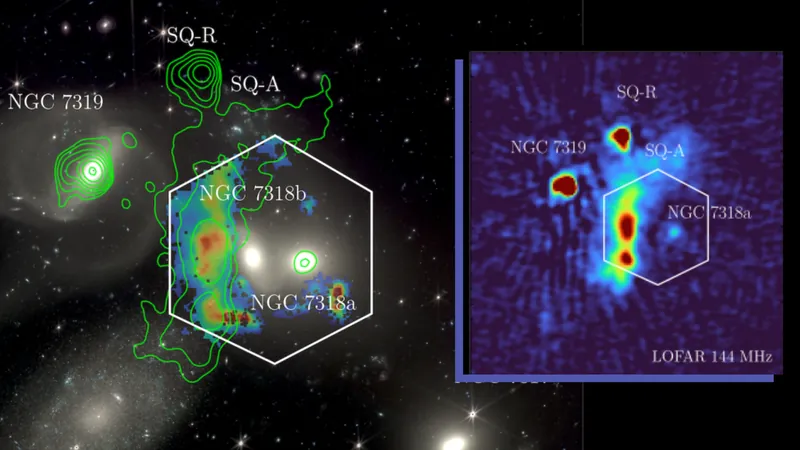
A Galactic Smash at 2 Million MPH! Has a Cosmic Catastrophe Reshaped Our Understanding of the Universe?
2024-11-22
Author: Ken Lee
Introduction
Astronomers have observed a breathtaking galactic collision unfolding at an astonishing speed of 2 million miles per hour (3.2 million kilometers per hour). This celestial event took place in a region known as "Stephan's Quintet," which is infamous for being a chaotic crossroads of multiple galaxy collisions throughout its history.
The Collision of NGC 7318b
The galaxy NGC 7318b barreled through this cosmic junction, triggering a massive shockwave that has rejuvenated interest in the Quintet, a grouping first discovered back in 1877. This recent interaction showcases the violent and tumultuous nature of galaxies as they evolve and merge over billions of years.
Cutting-Edge Technology
A team of over 60 researchers utilized the sophisticated William Herschel Telescope Enhanced Area Velocity Explorer (WEAVE) in La Palma, Spain, to capture these stunning cosmic dynamics. They augmented their findings with data from the state-of-the-art James Webb Space Telescope (JWST) and the Low-Frequency Array (LOFAR), aiming to unravel how such violent collisions contribute to the sprawling structure of the universe.
Scientific Insights
Marina Arnaudova, a leading researcher from the University of Hertfordshire, remarked on the significance of these observations, stating that "the awe-inspiring speed of NGC 7318b—surpassing even the mighty SR-71 Blackbird jet by around 800 times—creates shockwaves reminiscent of a sonic boom, leaving cosmic debris in its wake."
The Nature of Shockwaves
As the shockwave roars through regions of cold gas, it strips electrons away from atoms, generating a radiant trail of plasma that can be detected through WEAVE’s powerful instruments. However, when this mighty shock front encounters the hotter gas surrounding the site, it weakens, compressing the gas rather than causing devastation. This compression creates radio wave emissions that can be picked up by sensitive telescopes like LOFAR.
Broader Implications
The implications of these observations extend beyond just understanding the dynamics of Stephan's Quintet. Gavin Dalton, the principal investigator for WEAVE, emphasized the importance of this study: "These findings offer incredible insights into both the immediate phenomena occurring in our own universe and the deeper formation processes of distant, faint galaxies that lie beyond our current observational capabilities."
Future Collaborations
Excitement is in the air as astronomers look forward to future collaborations between WEAVE and pioneering space telescopes like the JWST. Marc Balcells, director of the Isaac Newton Group of Telescopes, conveyed his enthusiasm: "The impactful results from WEAVE's initial observations are only the beginning; we anticipate even more groundbreaking discoveries as our technological capabilities evolve."
Conclusion
This galactic event underscores the rich tapestry of cosmic interaction and evolution, inviting curiosity about what else awaits us in the vast, uncharted territories of the universe. Stay tuned, as the universe has more secrets yet to unveil!

 Brasil (PT)
Brasil (PT)
 Canada (EN)
Canada (EN)
 Chile (ES)
Chile (ES)
 España (ES)
España (ES)
 France (FR)
France (FR)
 Hong Kong (EN)
Hong Kong (EN)
 Italia (IT)
Italia (IT)
 日本 (JA)
日本 (JA)
 Magyarország (HU)
Magyarország (HU)
 Norge (NO)
Norge (NO)
 Polska (PL)
Polska (PL)
 Schweiz (DE)
Schweiz (DE)
 Singapore (EN)
Singapore (EN)
 Sverige (SV)
Sverige (SV)
 Suomi (FI)
Suomi (FI)
 Türkiye (TR)
Türkiye (TR)